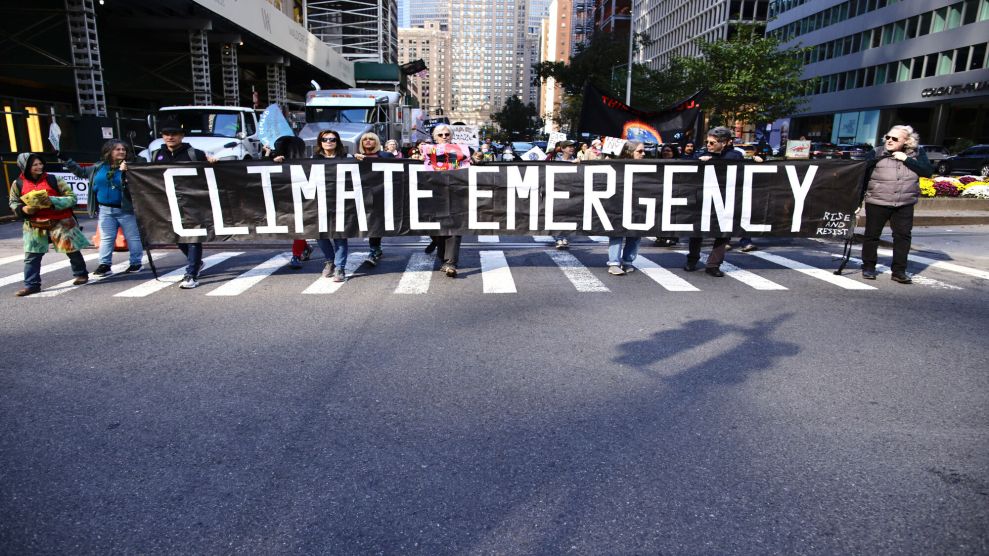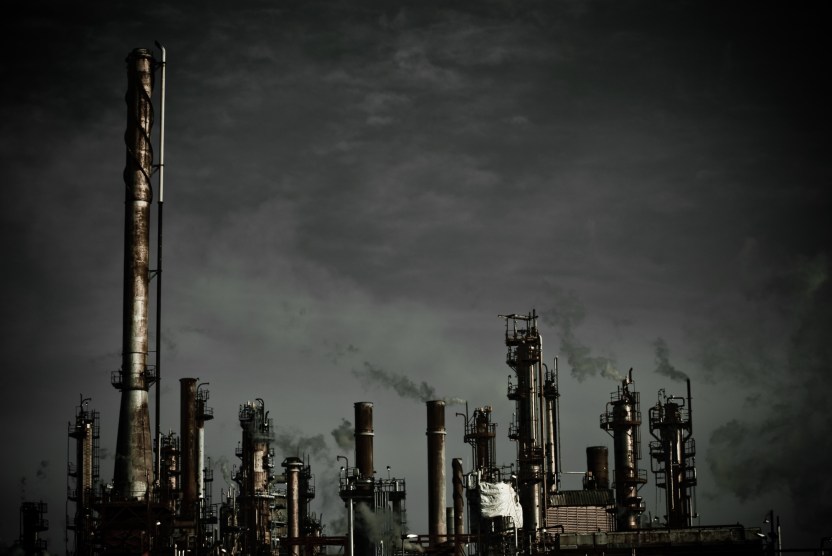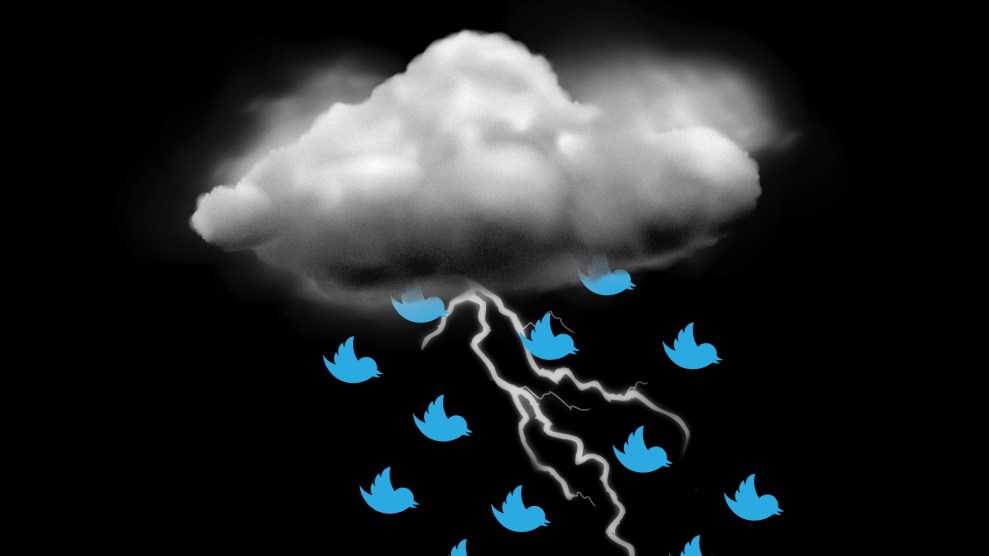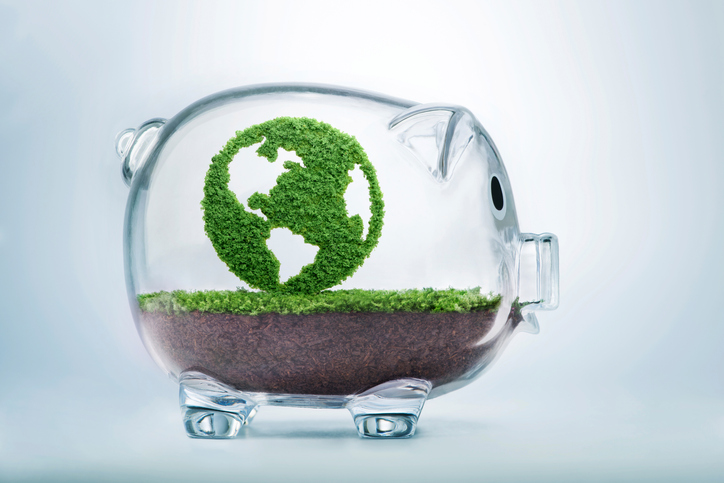
Climate activist protest as they march on Park Avenue in New York on October 29, 2022. Kena Betancur/AFP/Getty)
This piece was published originally by Capital & Main.
All good stories start with a question. So here are five questions for journalists to consider as the record-breaking accumulation of greenhouse gases continues into the opening days of 2023.
Climate change, of course, can’t be divided into parts. The answers to these questions, however you devise them, may start small and specific and then, like climate change itself, to borrow the title of a popular 2022 film, illustrate how it is “everything everywhere all at once.”
1) In what ways do the fossil fuel companies resemble a criminal conspiracy?
The territory of Puerto Rico is using a novel argument in a recently filed lawsuit alleging that oil and coal, and their paid allies, conspired to mislead the public over the costs and consequences of their greenhouse gas emissions. In the lawsuit, filed in early December, 16 Puerto Rican municipalities charged the companies under the RICO statute normally used to prosecute organized crime. The municipalities allege “decades of deception” by oil and coal companies, their trade associations and a network of funded think tanks to cast doubt on the connections between their greenhouse gas emitting products and the climate change-induced extremes (floods, droughts, hurricanes) that their residents have experienced over the past two decades.
That same constellation of companies and institutions is pretty much omnipresent in neighborhoods across the United States. The groundbreaking group of plaintiffs in Puerto Rico offer some pretty evocative descriptions of fossil fuel industry actions that most likely have occurred in cities and states elsewhere in the country. They cite evidence going back as far as 1989, when defendants ExxonMobil, Shell, BP and Rio Tinto launched a nonprofit corporation, the Global Climate Coalition, “to influence, advertise, and promote the interests of the fossil fuel industry by giving false information to their consumers and the public at large.” They allege that the companies’ aim, acting individually and collectively, is to convince the public that global warming is not occurring, and if it is, that there is no scientific consensus as to why. The damage caused in Puerto Rico by the extreme weather events of the last five years, they claim, can be traced to these efforts, which convinced governing authorities to resist actions that would help reduce greenhouse gas emissions, or properly prepare for their impact.
A similar constellation of companies and institutions have made the same misleading arguments in communities across the United States — starting in Washington, D.C., but also in state capitals across the country — where they have worked to undermine national, state and local responses to climate change. The Puerto Rican case will be watched closely for its use of the criminal, as opposed to civil, statutes, and builds upon a long trail of legal offensives to hold the industry accountable for the immense financial consequences of climate change for the public treasury — a drain on public funds that is being felt in every jurisdiction across the U.S.
2) What is a greenwash?
Public concerns over climate change have risen to such an extent that companies are now trying to ride the wave by describing their work with new environmentally friendly language. It’s time for journalists, and everyone else, to beware of virtue signaling in the climate realm. How to know if claims are real? The EU is devising rules to hold investment firms — many of them also operating in this country — accountable for their “sustainability” and other claims. The United Nations has already done so, with some tartly worded introductory remarks, “It’s Time to Draw a Red Line Around Greenwashing,” to the report “Integrity Matters: Net Zero Commitments by Businesses, Financial Institutions, Cities and Regions.” As the impacts of atmospheric disequilibrium become ever more clear, and the claims of companies in the spotlight ever more vaguely “green,” there will, no doubt, be abundant opportunities to hold companies accountable to their “net-zero” and other climate claims. Those guides provide some handy clues to watch out for. Maybe there’s a greenwash in motion wherever you are — and it won’t be in a laundromat.
3) Who will get water in the West?
Residents of southern Arizona and California are discovering amid plummeting Colorado River reservoir levels what scientists told us long ago: You can’t grow water. The inconvenient truth about water is that the amount of moisture in the atmosphere doesn’t change; it just moves or stays longer in the atmosphere, but it does not expand in quantity. So we are stuck with what we have — a water supply that spends more time in the ever-hotter atmosphere, and comes down in ways that are less and less predictable. Some areas become wetter, others drier. Though that truth shapes the situation with regard to this most fundamental of resources, there’s another truism for journalists that also still holds: Follow the water, or follow where it used to be. That trail leads to money, and money leads to power. Wherever you live in the West, water is guaranteed to be a story for a long time.
Start with the Colorado River, shift to the Tule and the Tuolumne and the Klamath, to the Sacramento and the San Joaquin — which feed, or not, the mighty pumps in Tracy sending water further south. Whatever river trail you follow, access to water in the West is what former Gov. Jerry Brown once called a “Hobbesian situation,” a fight over resources that is getting more brutal “as things get tighter” due to climate change. The battle over access to water, fought in locations across the West — along riverfronts, lakes, reservoirs, dams, canals, aqueducts, tunnels and every other form of channeling water in a direction other than that it would normally flow — promises to become more intense and more desperate as the sources of that water become more erratic and centers of moisture shift in the atmosphere. At every stage, it’s a question of who gets the water and who does not. Water stories often start small, where levees or tunnels or dams or diversionary channels are dug or proposed, and can lead very quickly to the most powerful interests in a state, a city, a town, all thirsty for a drink.
4) What does an earthquake have to do with solar power?
In the week before Christmas, a powerful earthquake registering 6.7 on the Richter scale rattled Humboldt County in Northern California. Tens of thousands of residents in Eureka and surrounding towns lost power for over two days when PG&E’s electrical grid failed. Other than those with generators, the only residents in and around Eureka who had power when the grid went down were residents who’d installed solar panels — which were largely unaffected by the power outage. There is little, if any, evidence linking earthquakes to climate change. In that same area, however, there have been major storms and fires — both of which have been intensified by climate change. In those natural disasters, similar patterns emerged: While the power grid went down, the solar panels kept generating electricity. For those living and reporting along the picturesque fault lines of California, it is worth considering what this tells us about solar not only as a carbon-clean energy source, but as a hedge against disasters.
And another angle into this highly topical storyline: In a cruel twist of timing for Humboldt County, in the days after the earthquake those residents with solar panels were able to read on their solar-recharged devices that the state Public Utilities Commission had sharply cut their payments for selling excess power back to the grid, known as net metering. That move, long advocated by PG&E and the energy lobby, suggests an abundant string of local stories as solar installations drop — which they’re expected to by as much as 40% because of the rate cut — just as rooftop solar’s use in emergency situations becomes more clear.
5) What do Indonesia, the Democratic Republic of the Congo and Brazil have to do with the weather in your neighborhood?
These three countries have the largest tropical forest areas in the world. They are home to an abundant diversity of species, and they are the world’s largest carbon sinks (reminder: Trees inhale carbon dioxide and exhale oxygen). At the recent Convention on Biological Diversity conference in Montreal, these three countries established an informal alliance, known as the OPEC of rainforests, to demand greater funding to ensure conservation of standing forests — often by indigenous communities who have lived in and protected the forest for millennia. Evaporation from those forests is also a critical ingredient in the huge flowing currents of moisture above our heads known as atmospheric rivers — which traverse the atmosphere and thus have a major influence on the weather (including on the recent rain and snowstorms that wreaked havoc in the U.S. over the holidays).
All three countries in the new alliance also produce oil, and are thus both contributors to the emissions that are degrading their forests and hosts to the carbon sinks that can mitigate the damage from them. Either way, it’s clear how deeply our fate is tied to those distant rainforests. Their vitality helps determine the severity of the droughts, floods, rising temperatures and other symptoms here that are being triggered by global warming. For journalists, such connections offer clear stakes to Americans, who are being asked, like the people in other developed countries, to contribute hundreds of millions of dollars in public funds to ensure those trees remain standing. The weather, that great standby of all news coverage, may be the greatest climate story of them all — and may just start with whether or not a far-off tree in a place where we may never have the good fortune to visit is cut or burned, or left standing.
Happy new year!













